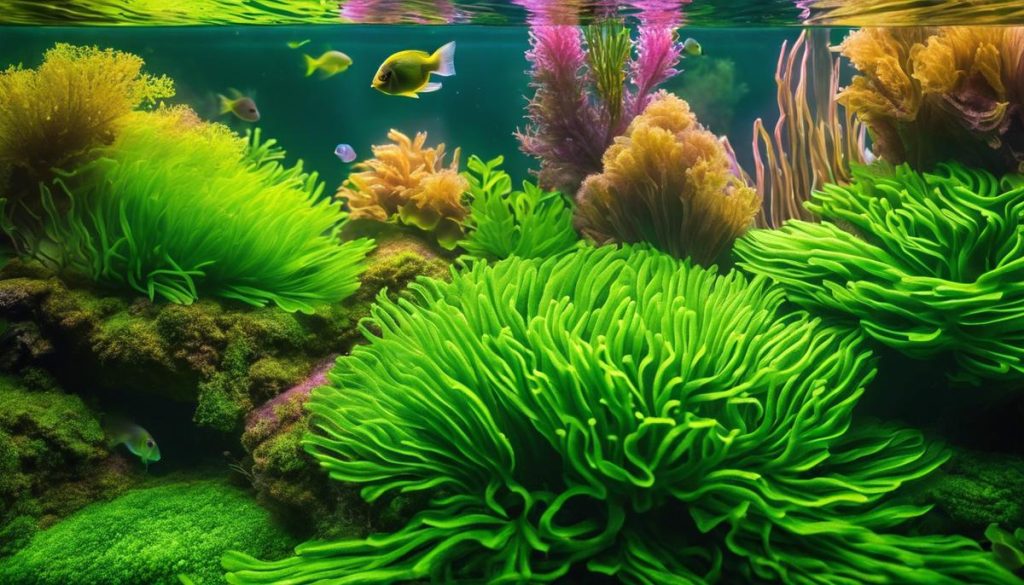How To Eradicating Green Algae from Your Fish Tank

Green algae can turn the exciting experience of keeping a fish tank and modern looking office into a constant struggle. It’s not just about how it mars the views of aquatic beauty, it can also affect the health of the inhabitants of the aquarium. Understanding the factors that facilitate the growth of green algae, like excessive lighting, improper water conditions, and overfeeding is the first step towards fixing the problem. Our essay will navigate you through understanding algae growth, preventing future growth and necessary algae removal techniques; all tailored towards maintaining the pond of your dreams.
Understanding Algae Growth
Understanding Green Algae Growth in Your Aquatic Realm: The Whys & the Hows!
Enthusiasts of the underwater universe know how a pinch of algae can turn into a verdant menace. Algae, specifically Green Algae, can quickly outnumber the population of your beautifully curated aquarium, turning it into a murky green water world. Luckily, understanding three key factors – light, nutrients, and tank maintenance – can put you a step ahead in preventing this kind of invasion.
- Too Much Light:
- Nutrient Overload:
- Tank Maintenance:
The first thing to note is the relationship between light and algae. Like plants on land, algae practice photosynthesis, turning light into their food. Hence, excessively long or intense artificial light, or placing your fish tank near a window where natural sunlight can penetrate, tends to foster a green playground for algae. Remember, a balance in lighting is vital – too little, and your plants suffer; too much, and you roll out a lush green carpet for algae.
The second condition suitable for green algae growth is an unbalanced nutrient presence in your aquatic setup. What constitutes these nutrients? Any organic matter, such as fish waste, decaying plant or food matter, turns into nitrates and phosphates, providing fertile soil for algae to flourish. Overfeeding your finned friends could contribute to extra nutrients, inviting an unnecessary green layer to your aquatic life.
Finally, the battle against green algae is critically dependent on overall fish tank hygiene. Neglecting cleaning routines, infrequent water changes, or poor filters that fail to eliminate toxins and decay, all contribute to an environment conducive for green algae to thrive.
But don’t let the thought of green algae deter you! Remember that a small amount of it is a normal part of any fish tank’s ecosystem. It’s when the scales are tipped heavily in algae’s favor that problems arise. The key to keeping the balance lies in control: regulating light exposure, ensuring a balanced diet for your fish, and practicing regular tank maintenance. That way you can enjoy your vessel of underwater marvel, sans the overwhelming green tinge!

Preventative Measures Against Algae
How To Keep Algae at Bay: Advanced Strategies and Treatment Ideas
Stepping up from prevalent knowledge in the world of aquatics, it’s time we dove into some advanced strategies you can employ to manage and prevent the growth of green algae in your aquarium. Continuing on from the basics, like the various factors contributing to algal bloom and a keen balance in light exposure and nutrients, let’s uncover further steps you can use to your advantage.
One notion that swim around is the use of biological control methods. Biological control involves using living organisms, including algae-eating fish or microorganisms. Selecting these species and incorporating them into your aquarium ecology will naturally help keep algae in check. Don’t forget to consider the type and size of your aquarium while making this decision. A short list of algae eaters includes Siamese Algae Eaters, Mollies, Plecostomus, and a variety of snails and shrimps.
Next in line is chemical control. From time to time, you may opt for using algaecides or specialized chemical treatments. These solutions can suppress excessive algae growth but should be used cautiously due to their potential impact on aquatic life. It’s essential to thoroughly read the instructions, only apply recommended doses, and monitor the effects on tank inhabitants critically.
Adventure further into the field by trying your hand at CO2 Injection. Yes! Injecting Carbon dioxide into your tank. Remember, CO2 is an essential ingredient to achieving lush plant growth in your aquarium. Healthy, thriving plants constantly compete against algae for the available resources, limiting their chances of overgrowth. However, continually monitor CO2 levels to avoid distressing fishes and other aquatic inhabitants.
Last but not least, don’t hesitate to experiment with Environmental Manipulation. This strategy revolves around improving water quality by frequently changing small amounts of water, using high-grade filters, or manipulating temperature conditions to curb algae growth. Bear in mind, creating conditions unfavorable to algae can often deter their proliferation.
Expanding your knowledge base by adopting these advanced steps – biological control, the judicious use of chemicals, CO2 injections, and environmental manipulation – you’re set to maintain your very own thriving, algae-controlled freshwater aquarium. Don’t forget, preventing algae growth isn’t about completely eradicating them but achieving equilibrium where everything, including fish, plants, and yes, algae, can thrive in harmony.

Algae Removal Techniques
Deep Dive into Algae Removal Techniques
Despite already understanding the complex relationship between light, nutrients, and maintenance surrounding algae growth, it’s time to roll up the sleeves and dive headfirst into practical solutions for existing green algae removal in your fish tank.
Physical Removal Methods
Manual removal is simple yet effective in reducing the quantity of algae present in the aquarium. Start out by donning a pair of aquarium-safe gloves. Then, gently scrub the tank walls with a sponge or an algae magnet to annihilate those green enemies. Also, remember to vacuum the substrate to eliminate potentially hidden algae.
In some cases where algae growth is rampant, manual removal might not suffice. It’s time to bring in the heavy artillery – the algicides. Use this as a last resort, however, as algicides can alter the chemistry and balance of water in a fish tank. Always follow the manufacturer’s instructions prudently when applying these chemicals.
Hydrogen Peroxide
A less aggressive, yet still forceful chemical approach can be achieved with the careful use of hydrogen peroxide. It targets algae without causing significant harm to the tank inhabitants. Spray a 3% solution on the affected areas during water changes, but always keep an eye on your aquatic pets just to be safe.
Activated Carbon
Incorporating an activated carbon filter in the tank can also reduce algae blooms. These filters trap phosphates – one of algae’s favorite meals – thereby effectively starving out the unwanted vegetation.
Introduce Algae Predators
Pro-tip: make use of nature’s own mechanisms. Certain species of fish and snails, such as Amano Shrimp, Nerite Snails, or Otocinclus Catfish, love feeding on algae. Introduce these critters into your tank, and they’ll make quick work of your undesired green visitors.
Diatom Filters
These filters, although not commonly used, offer a unique solution. They’re known to physically remove even the smallest algae particles from the water, leading to a reduction in algae over time.
It’s imperative to remember, though, while battling these pesky plants, that algae are a natural part of any aquarium ecosystem. It’s their overpopulation we’re trying to control, not their eradication. So, let the battle commence, but always aim for a peaceful co-existence. The lush, green, algae-free aquarium of your dreams awaits!

Mastering the art of aquarium keeping is a fascinating and rewarding endeavour, yet, it can be impeded by obstacles like green algae growth. Keeping an edge over this unwelcome guest doesn’t stop at its removal. It extends into preemptive measures such as regulating feeding practices, controlling light exposure, and making sure water conditions are optimal. By comprehending and acting on these guidelines, you can transform your fish tank into a thriving, algae-free aquatic ecosystem. So, let’s dive into employing these tools and techniques to keep our fish cheerful, and our aquariums scenic.


